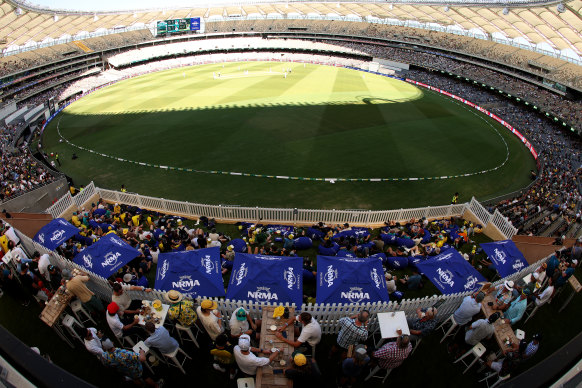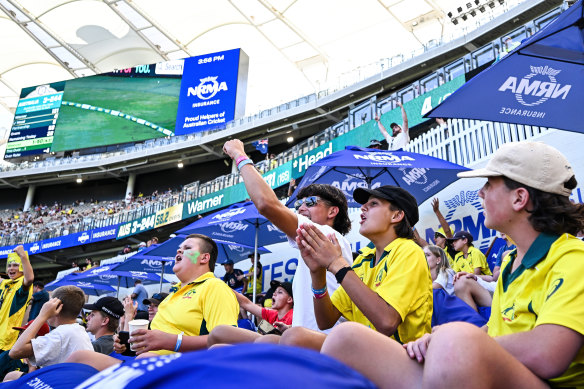
Save articles for later
Add articles to your saved list and come back to them any time.
When Cricket Australia sat down to negotiate its new broadcast deal with Foxtel and Seven this time last year, there was only one thing that mattered so far as the value of international cricket.
How many times were India and England touring over the course of the deal, and how many more matches were they going to play than last time?
The replica “WACA Hill” at Perth Stadium.Credit: Getty
For years beforehand, CA had been working with the Board of Control for Cricket in India and the England and Wales Cricket Board to guarantee regular tours, and to expand India’s series from four Test matches to five.
In the end, those talks added up to an increase from 13 Tests against India and England between 2018 and 2024 to 20 between 2024 and 2031 – the biggest single factor in the broadcast deal’s $1.512 billion value over seven years, next to the $1.18 billion price tag six years ago.
But what about the rest? India and England tours account for four of the next seven summers, leaving three others that may look a lot like this one. At the time of broadcast negotiations, plenty of gaps remained given the current future tours program runs only until 2027.
The attitude, according to one senior source with knowledge of broadcast talks, was along the lines of “we’ll fill in the other tours later”.
That process has already begun, with New Zealand’s 2026-27 tour to be expanded to four Tests, a Bangladesh series to be shifted from March to September, and a 150th anniversary Test to be played against – you guessed it – England at the MCG instead.
But it is hard to escape the sense that Test cricket against anyone other than England and India is very much on trial in Australia. Not only because of the commercial implications, but because so few other nations now have the money and talent in their systems to compete with the game’s biggest financial powers.
“We’re really trying to make sure the experience of Test cricket becomes a real event, and we’re attracting younger audiences,” CA’s chief executive, Nick Hockley, told this masthead.
“[A crowd of 16,259 on Thursday] was the highest attendance ever for a Test match against Pakistan in Perth. So we feel we’re on the right trajectory, but there’s plenty of space for people to come down over the weekend.
“We’ll keep working really hard, and we know there’s a really strong demand for cricket in Perth, we saw that at the final of the BBL. We’re pretty impatient to see Optus Stadium full, and it’s great that we’ve now got India and England coming the next two summers.”
Australia’s captain, Pat Cummins, admits to a feeling of conflict about the lopsided numbers.
“It’s a tough one,” he said on match eve in Perth. “Growing up, I remember some of the great battles of seeing Shoaib Akhtar charging in or some of the tussles against South Africa or West Indies … So it’s not always India and Ashes in my mind that are the big ones.
“But I can only speak as a player, and every Test match is huge. You want to play against players you haven’t played against a lot. These guys, probably half the team we haven’t played against or certainly not in Australia, so I quite like playing as many teams as we can.”
Pakistan’s skipper, the erudite Shan Masood, is clear about the fact his side needs to find a better way of playing Test cricket to gain the chance to play more. In 2023, admittedly a World Cup year, Pakistan will play just five Test matches in total. For the nation that produced Imran Khan, Wasim Akram, Javed Miandad and Younis Khan, it isn’t enough.
“We all love playing Test cricket, it’s the ultimate, the pinnacle,” Masood said. “Test cricket for us as a nation has taken a bit of a hit because we normally play six Test matches a year. If you count these three Test matches, it’ll be five for the year.
“So it’s not enough, we’d obviously like more Test cricket, and by being a side that is a winning side that produces results at home and overseas, we might get more Test cricket in the future. We want to play more, we want to play the best teams in the world, and we want to play an exciting brand of Test cricket.”
At the same time, Australian cricket venues are fighting over the rights to host the best matches in the best slots for summer. Mid-December, unusually the first Test of the season due to the World Cup in India, was coveted by Perth – which is yet to prove it can fill its new stadium for Test matches – and Adelaide, which has.
The question has become how to raise interest in Test summers that do not feature India or England.Credit: Getty Images
The award of this week’s Test to Western Australia rather than South Australia was the catalyst for a push by the South Australian Cricket Association to steal the new year’s Test from Sydney in future years, as CA attempts to create more competitive tension among state governments for matches.
These talks are heightened in stakes by the fact that India and England are here the next two seasons. But for Hockley and CA chair Mike Baird, the challenge remains to find a way of making all Test matches as vibrant as each other.
“In terms of what our partners want, and we want, it’s great cricket, great competition and great crowds,” Hockley said. “A key part of that is context to every single game and series, which is why the world Test championship is such a great innovation.”
The ultimate goal is to make Test cricket as big every year in Perth or Brisbane as it is on Boxing Day in Melbourne, the new year in Sydney, or pretty much any time in Adelaide. This would seem about as big a challenge as bowling to David Warner on day one.
News, results and expert analysis from the weekend of sport sent every Monday. Sign up for our Sport newsletter.
Most Viewed in Sport
From our partners
Source: Read Full Article

